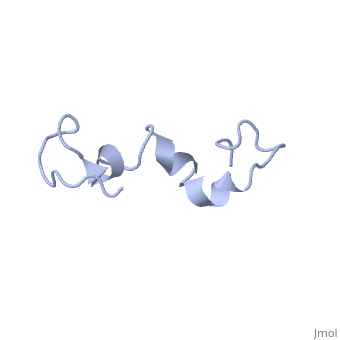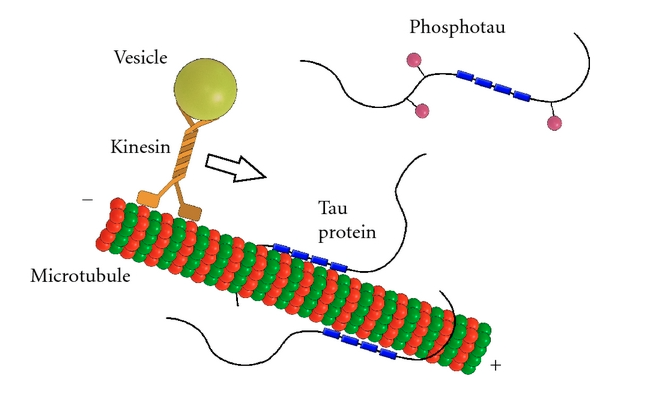User:Madelyn Kasprzak/Sandbox 92021
From Proteopedia
| Line 5: | Line 5: | ||
<Structure load='2MZ7' size='350' frame='true' align='right' caption='Human tau protein (PBD codes: 2MZ7, 4NP8, 4FL5)' scene='Insert optional scene name here' /> | <Structure load='2MZ7' size='350' frame='true' align='right' caption='Human tau protein (PBD codes: 2MZ7, 4NP8, 4FL5)' scene='Insert optional scene name here' /> | ||
| - | Additionally, tau has a transient secondary structure of α-helices, β-pleated sheets, and a poly-proline II helix <ref name="mandelkow"/>. Tau does not resemble a globular protein, but has characteristics of a denatured, unfolded protein which contributes to its overall hydrophilicity | + | Additionally, tau has a transient secondary structure of α-helices, β-pleated sheets, and a poly-proline II helix <ref name="mandelkow"/>. Tau does not resemble a globular protein, but has characteristics of a denatured, unfolded protein which contributes to its overall hydrophilicity <ref name="schweers">PMID: 7929085</ref>. It can also interact with other tau proteins to form <scene name='71/716561/Tau_aggregation/1'>aggregations</scene>. |
'''AlternativeSplicing''' | '''AlternativeSplicing''' | ||
| - | Alternative splicing of the human tau gene 17q21 generates several isoform structures, which differ by one or two small inserts in its N-terminal <ref name="Lei">PMID: 20678581</ref>. Although there are 16 exons within the 17q21 gene, exons 4A, 6, and 8 are expressed in peripheral rather than neural tau proteins <ref name="Buee">Buee, L, Bussiere, T, Buee-Scherrer, V, Delacourte, A, Hof, PR. Tau protein isoforms, phosphorylation and role in neurodegenerative disorders. Brain Res. Rev. 33:95-130 (2000). DOI: 10.1016/S0165-0173(00)00019-9</ref>. Alternatively, eight of the exons (1, 4, 5, 7, 9, 11, 12, and 13) are involved in structural aspects of tau | + | Alternative splicing of the human tau gene 17q21 generates several isoform structures, which differ by one or two small inserts in its N-terminal <ref name="Lei">PMID: 20678581</ref>. Although there are 16 exons within the 17q21 gene, exons 4A, 6, and 8 are expressed in peripheral rather than neural tau proteins <ref name="Buee">Buee, L, Bussiere, T, Buee-Scherrer, V, Delacourte, A, Hof, PR. Tau protein isoforms, phosphorylation and role in neurodegenerative disorders. Brain Res. Rev. 33:95-130 (2000). DOI: 10.1016/S0165-0173(00)00019-9</ref>. Alternatively, eight of the exons (1, 4, 5, 7, 9, 11, 12, and 13) are involved in structural aspects of tau <ref name="Buee"/>. Alternative splicing of exons 2, 3, and 10 is responsible for the 6 isoforms of tau <ref name="Lei"/>. These isoforms differ in 3 or 4 tubulin binding domains within the C-terminal region (Kolarova). It is also possible in several inserts of approximately 29 amino acids in the N-terminal (Kolarova et al., 2012). |
'''Chemical Alternations''' | '''Chemical Alternations''' | ||
| - | Tau proteins typically undergo post-translational modifications such as O-glycosylation and phosphorylation. O-glycosylation involves the addition of an O-linked N-acetylglucosamine residue on a serine or threonine amino acid adjacent to the proline-rich domain (Buée et al., 2000). This modification is not fully understood, however it may be involved in interactions with tubulin and degradation of tau proteins | + | Tau proteins typically undergo post-translational modifications such as O-glycosylation and phosphorylation. O-glycosylation involves the addition of an O-linked N-acetylglucosamine residue on a serine or threonine amino acid adjacent to the proline-rich domain (Buée et al., 2000). This modification is not fully understood, however it may be involved in interactions with tubulin and degradation of tau proteins <ref name="Buee"/>. Several phosphorylation sites (Figure 2) have been identified on mainly serine-proline and threonine-proline amino motifs <ref name="Buee"/>. Tau protein kinases typically catalyze the phosphorylation of tau; however, non-proline directed kinases could also phosphorylate other sites within tau <ref name="Buee"/>. Tau phosphorylation directly affects its ability to bind to microtubules <ref name="Buee"/>, as described below. |
'''Tau's Role in Microtubules and Axonal Transport''' | '''Tau's Role in Microtubules and Axonal Transport''' | ||
| - | Tau binds to microtubules and aids in their assembly and stabilization as well as the motor-driven transport of axons (Mietelska-Porowska et al., 2014). Its ability to stabilize microtubules is attributed to repetitive microtubule-binding motifs within its C-terminal region | + | Tau binds to microtubules and aids in their assembly and stabilization as well as the motor-driven transport of axons (Mietelska-Porowska et al., 2014). Its ability to stabilize microtubules is attributed to repetitive microtubule-binding motifs within its C-terminal region <ref name="Lei"/>. These 18-amino acid repeat domains bind to microtubules through weak interactions such as van der Waals or highly shielded ionic bonds (Butner & Kirschner, 1991). Specifically, the area <scene name='71/716561/Most_potent_part/1'>275-KVQIINKK-280</scene> in the interregion between repeats 1 and 2 is highly potent in microtubule polymerization (Kolarova). Although the repeat domains are similar in structure, they differ in their binding affinities, which is likely attributed to slight differences in their amino acid sequence (Butner & Kirschner, 1991). Their flexibility and lack of binding cooperativity further accentuate the protein’s transient secondary structure (Butner & Kirschner, 1991). |
The phosphorylation state of tau directly affects proper assembly and stabilization of microtubules (Kolarova et al., 2012). Phosphorylation is greatly increased when mutations of the tau protein are present (Alonso et al., 2004) or when other proteins such as <scene name='71/716561/4-3-3_and_tau/1'>14-3-3 bind to tau</scene> (CITE ME on GOOGLE DOC). Phosphate groups on a highly phosphorylated tau may disrupt non-covalent interactions between the protein and microtubules, which reduce tubulin stability and impair axonal transport. Thus, any abnormalities in the protein’s phosphorylation state may contribute to neurodegeneration, as described below (Rodríguez-Martin et al., 2013). | The phosphorylation state of tau directly affects proper assembly and stabilization of microtubules (Kolarova et al., 2012). Phosphorylation is greatly increased when mutations of the tau protein are present (Alonso et al., 2004) or when other proteins such as <scene name='71/716561/4-3-3_and_tau/1'>14-3-3 bind to tau</scene> (CITE ME on GOOGLE DOC). Phosphate groups on a highly phosphorylated tau may disrupt non-covalent interactions between the protein and microtubules, which reduce tubulin stability and impair axonal transport. Thus, any abnormalities in the protein’s phosphorylation state may contribute to neurodegeneration, as described below (Rodríguez-Martin et al., 2013). | ||
Revision as of 15:43, 6 December 2015
Structure and Function
The human tau protein, encoded by chromosome 17q21, has a natively unfolded protein structure, which contributes to its flexibility and ability to stabilize functional microtubules [1]. Specifically, its primary structure, consisting of , is highly hydrophilic compared to other cytosolic proteins [1]. It has a predominantly acidic N-terminal, a proline-rich middle region, and a relatively neutral C-terminal region [1].
|
Additionally, tau has a transient secondary structure of α-helices, β-pleated sheets, and a poly-proline II helix [1]. Tau does not resemble a globular protein, but has characteristics of a denatured, unfolded protein which contributes to its overall hydrophilicity [2]. It can also interact with other tau proteins to form .
AlternativeSplicing
Alternative splicing of the human tau gene 17q21 generates several isoform structures, which differ by one or two small inserts in its N-terminal [3]. Although there are 16 exons within the 17q21 gene, exons 4A, 6, and 8 are expressed in peripheral rather than neural tau proteins [4]. Alternatively, eight of the exons (1, 4, 5, 7, 9, 11, 12, and 13) are involved in structural aspects of tau [4]. Alternative splicing of exons 2, 3, and 10 is responsible for the 6 isoforms of tau [3]. These isoforms differ in 3 or 4 tubulin binding domains within the C-terminal region (Kolarova). It is also possible in several inserts of approximately 29 amino acids in the N-terminal (Kolarova et al., 2012).
Chemical Alternations Tau proteins typically undergo post-translational modifications such as O-glycosylation and phosphorylation. O-glycosylation involves the addition of an O-linked N-acetylglucosamine residue on a serine or threonine amino acid adjacent to the proline-rich domain (Buée et al., 2000). This modification is not fully understood, however it may be involved in interactions with tubulin and degradation of tau proteins [4]. Several phosphorylation sites (Figure 2) have been identified on mainly serine-proline and threonine-proline amino motifs [4]. Tau protein kinases typically catalyze the phosphorylation of tau; however, non-proline directed kinases could also phosphorylate other sites within tau [4]. Tau phosphorylation directly affects its ability to bind to microtubules [4], as described below.
Tau's Role in Microtubules and Axonal Transport Tau binds to microtubules and aids in their assembly and stabilization as well as the motor-driven transport of axons (Mietelska-Porowska et al., 2014). Its ability to stabilize microtubules is attributed to repetitive microtubule-binding motifs within its C-terminal region [3]. These 18-amino acid repeat domains bind to microtubules through weak interactions such as van der Waals or highly shielded ionic bonds (Butner & Kirschner, 1991). Specifically, the area in the interregion between repeats 1 and 2 is highly potent in microtubule polymerization (Kolarova). Although the repeat domains are similar in structure, they differ in their binding affinities, which is likely attributed to slight differences in their amino acid sequence (Butner & Kirschner, 1991). Their flexibility and lack of binding cooperativity further accentuate the protein’s transient secondary structure (Butner & Kirschner, 1991).
The phosphorylation state of tau directly affects proper assembly and stabilization of microtubules (Kolarova et al., 2012). Phosphorylation is greatly increased when mutations of the tau protein are present (Alonso et al., 2004) or when other proteins such as (CITE ME on GOOGLE DOC). Phosphate groups on a highly phosphorylated tau may disrupt non-covalent interactions between the protein and microtubules, which reduce tubulin stability and impair axonal transport. Thus, any abnormalities in the protein’s phosphorylation state may contribute to neurodegeneration, as described below (Rodríguez-Martin et al., 2013).
Disease Relation
Alzheimer’s disease and dementia A common abnormality in tau phosphorylation, associated with Alzheimer’s disease, is the phosphorylation of two serine-proline motifs located 199 or 202 amino acids upstream of the microtubule-binding region (Biernat et al., 1992). Phosphorylated helical filaments within these motifs can lead to neurofibrillary tangles-aggregations of tau proteins (Schweers et al., 1994). Lysine acetylation catalyzed by tau autoacetyltransferase activity can also lead to tau aggregation, thereby preventing tau from interacting with microtubules (Cohen et al., 2013). Dysfunction of the neuronal cell, likely caused by tau aggregation, can lead to gradual but steady neurodegeneration, which is correlated with the onset of dementia (Kolarova et al., 2012; Kadavath et al., 2015). Tau aggregation may contribute to neuronal loss via cell death in areas of the brain responsible for memory and learning (Kolarova et al., 2012; Lansdall, 2014).
Parkinson’s disease Protein aggregation also exists in patients suffering from Parkinson’s disease, specifically within the substantia nigra of the midbrain (Ross, 2004). Immunohistochemical studies reveal that abnormally phosphorylated tau proteins are partially involved in the development of lewy bodies, protein aggregates, within the substantia nigra (Ishizawa et al., 2003). Lewy bodies may be involved in the neurodegeneration of dopaminergic neurons within this area (Ross, 2004).
References
- ↑ 1.0 1.1 1.2 1.3 Mandelkow EM, Mandelkow E. Biochemistry and cell biology of tau protein in neurofibrillary degeneration. Cold Spring Harb Perspect Med. 2012 Jul;2(7):a006247. doi:, 10.1101/cshperspect.a006247. PMID:22762014 doi:http://dx.doi.org/10.1101/cshperspect.a006247
- ↑ Schweers O, Schonbrunn-Hanebeck E, Marx A, Mandelkow E. Structural studies of tau protein and Alzheimer paired helical filaments show no evidence for beta-structure. J Biol Chem. 1994 Sep 30;269(39):24290-7. PMID:7929085
- ↑ 3.0 3.1 3.2 Lei P, Ayton S, Finkelstein DI, Adlard PA, Masters CL, Bush AI. Tau protein: relevance to Parkinson's disease. Int J Biochem Cell Biol. 2010 Nov;42(11):1775-8. doi:, 10.1016/j.biocel.2010.07.016. Epub 2010 Aug 1. PMID:20678581 doi:http://dx.doi.org/10.1016/j.biocel.2010.07.016
- ↑ 4.0 4.1 4.2 4.3 4.4 4.5 Buee, L, Bussiere, T, Buee-Scherrer, V, Delacourte, A, Hof, PR. Tau protein isoforms, phosphorylation and role in neurodegenerative disorders. Brain Res. Rev. 33:95-130 (2000). DOI: 10.1016/S0165-0173(00)00019-9


